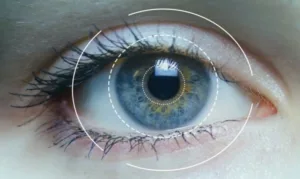Some are calling it the fifth modality for human computer interface, adding eye tracking to already established list that includes keyboards, mice, touch pads (or touch displays) and voice/gesture. (One could even argue it’s really closer to the sixth sense, as much like human intuition, the modality is quite discrete.) Like its counterparts, the impact of eye tracking is quite pervasive, and growing, with the potential to touch all things computing.
It now goes well beyond early applications such as the user interface (camera and cursor control) and is now used to add significant benefits to AR VR technology, (foveated rendering where the GPU power is applied only where the user is looking) gaming (more intuitive UI), advertising (eyeball counting), market research (neuro-marketing evaluations) with applications even in medical diagnostics
A recent Ben Dickson article on the topic, in TheNextWeb quotes Tobii Tech’s VP Oscar Werner “Gaze always precedes any kind of action that you do with mouse, keyboard and voice, so much smarter user interactions will be designed using these technologies, …it makes a device aware of what the user is interested in at any given point in time, [and] provides an additional way to interact with content, without taking anything else away.” As Werner puts it, eye tracking technology will “…increases the communication bandwidth between the user and the device.”
Our publisher, Bob Raikes, has long been a proponent of the adoption of gaze as part of the way that users should interact with their systems and wrote a Display Daily a couple of years that mentioned this (Look, Don’t Touch – Gaze Saves Time). His phrase is ‘If you know where I’m looking, you know what I’m interested in’. At CES, Bob caught up with Tobii in a private suite, and subscribers can read his account last month of their work in the gaming and mobile markets, Tobii Looking at Gaming, Power and Mobiles
Specific to advertising, the technology is helping move beyond impressions and clicks (from both human and non-human or ‘bot’ sources). The promise of adverts in the internet age was a shift toward bi-directional interaction using web browsers that has successfully shifted significant ad dollars from a simple broadcasting model. The old adage was that advertisers and agencies knew that only half of their spending effective, but not which half. But in the age of bots and ad blockers, eye tracking can give an added layer of assurance of just where (and who) is reading the content.
Case in point is Impax Media with its TruView eye tracking technology that provides multiple solutions for advertisers. It uses display screens with “built-in sensors and “proprietary TruView eye-tracking technology [that is, facial detection to measure datapoints on a face] to collect and analyze viewing data,” according to the Impax web site. “The screens recognize eye contact and activate a time-counter for each view, measuring the number of people who see your content and how long they spend watching it.”
So just as the five senses help animate the human body in our physical 3D world, eye tracking will give the power of vision to the computer programmers, EE and CS engineers building our next generation technology, with much of it centered on displays with significant impact. Tobii Tech’s, Werner states, “As vision is the most used sense among human beings, being able to track and measure it digitally will have a great impact on how we make our intentions known to computers, wittingly or unwittingly.” Opening up the eyes to the digital world has the potential to bring us that much closer to a place that truly reflects, augments and ultimately serves our own best purpose. – Steven Sechrist
Related articles on EyeTracking in our subscriber newsletters:
Tobii Looking at Gaming, Power and Mobiles
Eyetracking and Tobii Show, well, Eyetracking
FOVE Shows Eyetracking Technology
Fove with Eye-tracking Open for Orders

